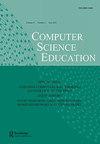Emotions and programming learning: systematic mapping
IF 2.2
Q1 EDUCATION & EDUCATIONAL RESEARCH
引用次数: 7
Abstract
ABSTRACT Background and context Emotions are ubiquitous in academic settings and affect learning strategies, motivation to persevere, and academic outcomes, however they have not figured prominently in research on learning to program at the university level. Objective To summarize the current knowledge available on the effect of emotions on students while they learn to program. We were interested in what emotions have been studied, what kind of tools researchers have used to measure students’ emotions, what emotions arise most frequently when students learn to program, and how researchers use this knowledge. Method A search of academic databases was performed using a search string constructed using PICo as a framework. A group of 29 studies that met the inclusion criteria were analyzed to answer a set of research questions derived from the study objective. Findings Few studies have been conducted on the influence of emotions on learning programming. Research studies do not address gender differences. Research has been oriented along three main lines (a) determining what emotions are involved in the process of learning to program; (b) determining the behavioral patterns of novice students and how from this behavior their emotions can be identified; and (c) developing intelligent systems that respond adaptively to students’ emotions. Implications The results provide an important foundation for researchers and instructors who are willing to recognize that learning to program generates strong emotions in students and that these emotions influence their learning and academic performance.情感和编程学习:系统映射
在学术环境中,情绪无处不在,影响着学习策略、坚持的动机和学术成果,然而,在大学水平的编程学习研究中,情绪并没有占据突出地位。目的总结目前关于情绪对学生编程学习的影响的知识。我们感兴趣的是研究了哪些情绪,研究人员使用了什么样的工具来测量学生的情绪,当学生学习编程时,什么情绪最常出现,以及研究人员如何使用这些知识。方法以PICo为框架构建检索字符串,对学术数据库进行检索。对符合纳入标准的29项研究进行分析,以回答一系列源于研究目标的研究问题。关于情绪对学习程序设计影响的研究很少。研究没有涉及性别差异。研究主要有三个方向:(a)确定在学习编程的过程中涉及哪些情绪;(b)确定新手的行为模式,以及如何从这种行为中识别他们的情绪;(c)开发能够适应学生情绪的智能系统。研究结果为研究人员和教师提供了重要的基础,他们愿意认识到学习编程会使学生产生强烈的情绪,这些情绪会影响他们的学习和学业成绩。
本文章由计算机程序翻译,如有差异,请以英文原文为准。
求助全文
约1分钟内获得全文
求助全文
来源期刊

Computer Science Education
EDUCATION & EDUCATIONAL RESEARCH-
CiteScore
6.90
自引率
3.70%
发文量
23
期刊介绍:
Computer Science Education publishes high-quality papers with a specific focus on teaching and learning within the computing discipline. The journal seeks novel contributions that are accessible and of interest to researchers and practitioners alike. We invite work with learners of all ages and across both classroom and out-of-classroom learning contexts.
 求助内容:
求助内容: 应助结果提醒方式:
应助结果提醒方式:


